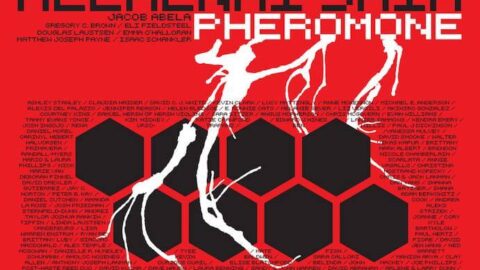In the life of an artist, there is often a defining moment that serves as a crucial point on their creative trajectory and solidifies their unique artistic identity— for flutist Meerenai Shim, her new album Pheromone is that defining moment. Featuring all electro-acoustic works by Eli Fieldsteel, Gregory C. Brown, Emma O’Halloran, Douglas Laustsen, Isaac Schankler, and Matthew Joseph Payne, Pheromone is Shim’s third album and the debut release for her newly-formed record label Aerocade Music. The album follows Shim’s two previous releases: Sometimes the City is Silent (2011) and The Art of Noise (2013), and while these albums are not to be overlooked, Pheromone stands in a class of its own. This album’s dedication to all electro-acoustic compositions definitively breaks from traditional repertoire and instrumentation, unapologetically plays to Shim’s strengths, and highlights her incredible versatility as a contemporary artist.
Eli Fieldsteel’s Fractus III: Aerophoneme for flute and live electronic sound was not specifically commissioned for this project, but it served as the inspiration for an entirely electro-acoustic album. Fieldsteel employs percussive effects, singing and playing, whistle tones, flutter tonguing, pitch bending, and jet whistles for the flutist as he explores the interaction of live performer and live electronics. This piece is ultimately a study in contrasts: texturally-fractured short motivic ideas vs. long, singing, lyrical melodic lines; groove-based passages vs. chaotic washes of electronic sound; microtonality vs. standard tuning; and acoustically-produced sound vs. electronically-produced sound. One unique feature of Pheromone’s liner notes is an equipment listing for each piece, and this listing reveals that this first track was intended to be performed with a quadrophonic output. The lack of the visual and spatial experience on a recorded medium is a sacrifice that many electro-acoustic works must make in order to be widely-disseminated; Fractus III: Aerophoneme is still a highly effective work as a recording, yet it leaves the listener yearning for the heightened live performance experience rather than the stereo recording presented on this album.

Gregory C. Brown’s Huge Blank Canvas Neck Tattoo for alto flute and digital delay requires the flutist to use loopers in order to sample portions of the piece in real-time, and the decisions made at the beginning of each section control the trajectory of the ensuing material. The first section is a build of short motivic bursts and juxtaposed fragments; the second section is more contrapuntal in nature; and the final section features the steadiest pulse, longer melodic lines, and a slower rate of build.
Whereas many works on this album are comprised of clearly contrasting sections, Emma O’Halloran’s Pencilled Wings for flute, piano, and stereo playback presents a solid fabric of sound that has gradual rises and falls but maintains a more fundamentally unified timbre throughout. Though the electronics provide a loose rhythmic pulse, the dynamic swells within these pulsations create the sensation of floating on endless waves of sound. Undoubtedly one of the highlights of this work is the bass drop after spending an extended period of time in the initial the sonic landscape of etherial harmonics, high frequencies, and the upper range of the piano.
Douglas Laustsen‘s 60.8% for bass flute and electronics uses elements from the musical style rebetiko– a style often sung in bars and prisons that depicts sad tales– to capture the “disillusion and struggle” of unemployed young Greeks in the wake of worldwide economic crisis. Laustsen combines everyday sounds (clanking glass, the flick of a lighter) with synthesized sounds and bass flute. The opening section features a lyrical, vocally-conceived, folk-like melody while the second section introduces a regular rhythmic pulse and combines the high register of the bass flute with synthesized sounds. It is at this point of the album where Shim’s versatility becomes astoundingly clear as one realizes that she demonstrates equal control and virtuosity on multiple instruments including the standard C flute, quarter-tone Kingma system flute, alto flute, and bass flute.
The eponymous track on the album, Isaac Schankler‘s Pheromone for flutes (C flute and bass flute), piano, and electronics, places the flute and piano in the foreground while the electronics echo in the background as a supporting layer of sound. The flute and piano lines interact in a quasi-minimalist and, at times, almost heterophonic fashion, and this driving texture showcases the pristine ensemble precision between Shim and pianist Jacob Abela. The album concludes with a microtonally-tinged and delightfully funky Etude for contrabass flute and TI83+ calculator by Matthew Joseph Payne. At just under two minutes, this work is the perfect combination of light-hearted and well-executed to draw this electro-acoustic journey to a close.
What is blatantly obvious from this album is that Meerenai Shim is thriving in the constantly shifting intersection of acoustic and electronic music. While her execution of extended techniques, pitch accuracy in microtonal passages, mastery of multiple instruments, and familiarity with both fixed and interactive electronics are at the core of this album, perhaps the most impressive moments are those where soaring, simple lyrical lines remind the listener that, contemporary techniques aside, Shim is fundamentally a great flutist.
























